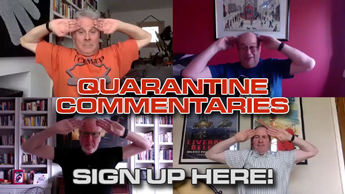 |
The Phantom Flibble From Kubrick to Polanski, Hancock to the Beatles, Gil Taylor has worked as a cinematographer with some of the finest directors and biggest stars of the twentieth century. But in the first part of this exclusive interview, Gil talks exclusively about his time on one movie in particular - the original Star Wars: Episode IV - A New Hope. |

Andrew Ellard
Mr Flibble apologised, but found himself so in awe of Gil that he was speechless. The rest of this interview had to be conducted without him.
Just towards the end of The Omen (1976) I was invited to lunch with George Lucas and Gary Kurtz," Gil says when asked how he became involved with Star Wars (1977). "I could see they were drinking water and orange juice, so when the waiter came over with a bottle of vino, I said, 'I'll have a glass of wine.' The reaction was tremendous; it was almost like an electric shock to a lunatic. I was only having a glass of wine!
"We discussed Dr Strangelove (1964), which was supposed to be the reason that they chose me and we also talked about The Omen a bit. Lucas then asked if I would like to do his movie. I thought from horror to space was a bit of a [leap], but I agreed to do it."
Leap or not, Gil was surprised to say the least when he saw the film's shooting script. "I was given a great big script, about 300 pages, containing all sorts of funny names, Christ knows what. Nothing about what anything really was, or how to make them or do them. And all this was the way he wanted to do it. He wouldn't talk about sets or anything."
The set building had already been running for a few weeks when Gil signed up, and he was swiftly flown - with Lucas and Kurtz - to the famous Tunisa locations for a recce. "The art department was mostly out there. We'd flown to Tunis together but nobody said anything - no one spoke."
"We were met by the production designer [John Barry] and we got into this piddly little car, there was only room for four, with no air conditioning, and we had to motor around for kilometres to where we wanted to go. Gary wore a big Stetson hat, and George a tennis cap."
"I recall, there was a big argument in the car between John, Gary and George about costs. Anyway, we got out of the car on the first set, and it was a great hole in the ground and meant to be some sort of strange farm, and on the other side was a cave [with] some white markings on it. So George said, 'Those marks, they're not wide enough.' The production designer said, 'I've changed these three times already. How wide do you want it?' 'I want it about a metre.' So the production designer said, 'You hold your hand up to tell me what you think is a metre.' George held his fingers up, the production designer said, 'Measure that.' It was 14 inches!"
Lucas was apparently already concerned about the escalating budget and suggested that the sets be made of the cheapest material possible. (Ironically, Star Wars fans have often noted the cardboard extras in the film's final award ceremony scene.) However, the production team were keen to make the sets less flimsy.
"He couldn't understand why we were making all this stuff so solid, and why wasn't it all temporary as it was on Graffiti," Gil remembers. "In the event, when we got out there [on] the first day [of shooting] the sets had all blown down, because they had had a hurricane - it soon became clear that cardboard sets would have lasted about 2 seconds."
If Gil found the massive shooting script somewhat impractical, he also took particular exception to Kurtz's comments as the cinematographer began his work:
"I started going around with my viewfinder looking for shots, and Gary Kurtz, the producer, said, 'What are you doing?' I said, 'I'm just trying to get a few shots lined up in my mind.' He said, 'I don't know what you're doing that for, because George will do it all in one shot.' I said, 'We've got 42 pages of script out here. I very much doubt that George will do this in one shot.' I know now I should have resigned then."
The poor weather in Tunisia made the filming of the Tunisia/Tatooine sequences doubly difficult. Reports from the set are conflicting, but it appears that diffusion was used on the camera to disguise the soggy sand and dull sky.
Some accounts suggest that a traditional technique - one Gil Taylor had used on The Omen previously - was used to provide the required effect: nylon stockings. Placed over the camera lens, the stockings provided a filter, which diffused the image.
Certainly Lucas seemed to want this effect, which gave the footage a fairy-tale-like quality. Gil seemed less keen. "When we got there [on] the first day, it was overcast - you couldn't tell the difference between the sand, the sky, anything. It was way off in the distance where Artoo and Threepio were to come down in a pod, so my son Peter, who was the first assistant, came up to me and said, 'George wants us to put a 300 on and use a heavy diffusion.' I said, 'You're joking! You won't even see them!'"
"He said [he'd use diffusion], and I said I'd go back on the plane rather than do that. I said, 'There's so much optical work on this film, we want clarity. You'll lose all your beautiful star backgrounds, all your space things. You can't do it, and I'm not going to do it. I'd rather go home.'"
In the end, however, Gil elected to stay with the film - and with Lucas - and even provided the diffusion he was loathe to give: "So anyway, I put the bloody lens on, and got him to look through. He said he wanted heavy diffusion on the film and all sorts of stuff. I discussed clarity with him, and also that the sets shouldn't be new, they should be made to look as if they were used, not brand new."
Whether it was at Gil�s suggestion or Lucas' own idea, shortly after the sets were built Lucas was to be found walking through the miles of set ordering that they be made more dirty -a look which changed the film permanently. Even R2-D2 was attacked with a saw and rolled in the dirt to provide the right 'distressed' look.
It would appear that the sets presented another problem for Gil - lighting. The lack of communication seemed to have spread right across the production. "When I came back from Tunis, I'd not seen any drawings of the sets. I came onto the floor, and they were putting up this huge, great big [set] - and it was painted as dark as coal! There were no lights on anything, there were no lights down the corridors, nothing."
"I'd discussed - in short discussion with George Lucas - that I wanted to light the sets with their own light sources, so I wouldn't have to do any lighting, it would all be done. And I thought that was what they were going to do."
"I went raving bloody mad, I said, 'Look, I can't do this. This is going to look just dreadful, it'll be awful.' So I went to the art department and I said, 'Look, I can't shoot on this, this is rubbish.' He said, 'What do you want to do, then?' I said, 'Well, I've got to do some experiments...'"
Some hurried rebuilding was called for in order for the set to be adequately lit. "In that week before we were shooting, it turned into the Star Wars that you see. I had to order 9000 bloody photofloods to light it from behind, so wherever you looked at it, from any angle, it would still be brilliant."
Did Lucas appreciate the changes? "Wherever you were on the set, whether they had white uniforms or black, I could control that light all on major dimmers. He could shoot in any direction, in any way."
With the action well lit, another lighting problem became apparent for the film's most iconic creation - the Lightsabre. Based on Lucas' concept, designer John Stears had come up with a weapon which featured a revolving blade, lit from within. However impressive visually, the blades were far too fragile for combat and likely to shatter on impact.
Bob Anderson, the fight arranger, had to come up with a new technique to bring the idea into three dimensions - one which relied on more traditional methods for a seasoned cinematographer like Gil:
"When it came to assisting in the development of the laser sword, I pulled out the script and I thought, 'Well, we need this laser [sword] thing.' So with the camera boys we got some pieces of wood cut by the chippies and mounted [them] on motors and put 3M [light reflective] material on, and had the boys fighting with laser-swords. Gary came and looked through the camera, and then I got special effects through. I could shoot the actors through the lens, with a little spotlight on the side on these [swords]."
This technique was reportedly used on both subsequent Star Wars films - The Empire Strikes Back and Return of the Jedi (although the results failed to please Lucas, who elected to enhance the effect with animation). Gil, however, remains adamant that its use began on Star Wars, with him lighting the blades with a small spotlight.
The Star Wars series is famed for its cutting-edge special effects, but being part of the first wave of a new type of cinema is not without its problems. Gil recalls his introduction to R2-D2 as being particularly problematic:
"The whole film was supposed to be, I was told, so modern that everything was automatic, all the models would be wondrous. And we went to see Artoo delivered to the studio. So we got into the special effects department, and Artoo took one step forward and fell flat on its face! Three days later we went to see this wonderful machine again, and it took one step forward and fell flat on its face. It wasn't until Kenny Baker became involved that the Artoo model became workable."
By all accounts the bumpy desert sands made even Baker's involvement a difficulty, and for some sequences the hollow R2 shell was simply towed around on hidden cables. And if that was disappointing, Lucas must have been mortified that the landspeeder - initially planned to rest on a cantilever arm out of shot - just would not work on film.
"George was working on the model that flew, like a Volkswagen thing, and he spent 75,000 quid trying to get that to fly. I remember that bloody Volkswagen - every frame [of film] had to be [altered] so you couldn't see the wheels on it!"
One of the most talked-about confrontations on Star Wars was between the technical crew and Lucas over working hours. Lucas was told that the crew would quit each day at 5:30pm - as was normal. Lucas had not anticipated this condition, and swiftly ended up behind schedule. Gil remains sanguine about the issue.
"ABPC [Associated British Picture Company] had a rule - I could only work 15 minutes overtime one day a week, and not Friday. They packed up at six o'clock; even the phones packed up. You couldn't make a call out of the studio in your office because they'd packed up, the girls went home. And that was the rule they wouldn't change for George Lucas, and said so to me. They weren't going to change it for him."
"It was nothing to do with the crew, because the crew would have worked and done anything for anybody. But the strict ruling with ABPC was you got there at half-past eight, you packed up at twenty past five, and that was it; filming was finished. Even [John] Houston couldn't change that."
"Houston did Moby Dick (1956) there, and he discovered it. He said, 'This f-ing outfit...' They were all moaning about the ruling. But let's face it, it's a very successful company."
So did Gil have arguments with Lucas? "We never had arguments - we didn't talk really, because he didn't want to talk. He'd hide himself away all the time in Tunis."
Gil's relationship with Lucas was never close, and communication throughout filming was not forthcoming. "In my view, he didn't want to have a serious conversation about anything," Gil recalls. "Even actors say the worst thing in the world is to go and have lunch with George Lucas - because he never speaks."
Famous for being withdrawn during filming - directing actors in such slight ways that a running joke on set was that he only used two expressions, 'better' and 'more intense' - Lucas' relationship with his actors is something Gil remembers particularly well:
"If Alec Guinness didn't like the dialogue, he changed it so he could say it. The other actors used to say, 'We can't bloody well say this, George.' So George hated rehearsing them because they didn't like what they were saying."
"In Tunisia I was sitting at a table with Alec Guinness having lunch and a reporter said to Guinness 'How are you getting on with this young director?' And Guinness said, 'I wish I could answer that but I've never really had a conversation with him.'"
Was Gil aware of the potency of the film? "I had no idea it would be such a success, I thought it was so corny and many of the American actors were unknown then and rough around the edges. When the girl came on the set, she had to run across, her arms were going like this." Gil waves his arms enthusiastically. "I went to her and I quietly whispered, like I always do, 'You know darling, don't run across with your arms up, you look like you're pulling pints of beer.'"
"But otherwise, from my point of view, it was a wonderful crew, the same crew I worked with on Omen, and we had lots of laughs."
Mr Flibble remained silent, still in awe of a legend of cinema. In part two of this exclusive interview, Gil will be talking about Stanley Kubrick and Peter Sellers on the classic satire, Dr. Strangelove. If you don't tune in... Mr Flibble will be very cross.














